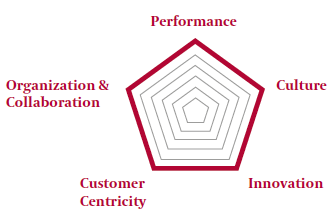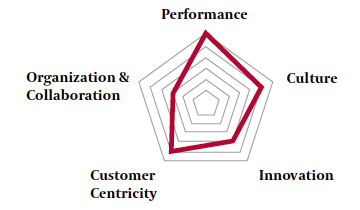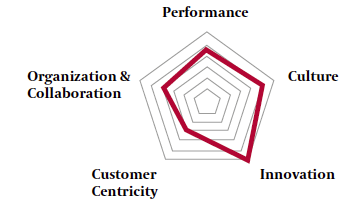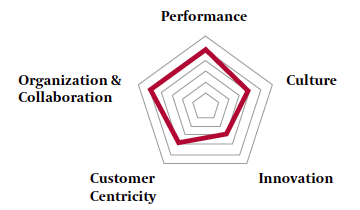In the digital age, companies in every industry must unleash a new wave of innovation – or be disrupted by aggressive new competitors. Digital is transforming everything from consumer behavior to employee engagement to the management of cities and infrastructure. Companies that embrace this transformation can inspire visions of a very different future, reimagine their business models and organizations, and create tremendous value and growth. But those that fail will see their very existence under threat. The stakes have never been higher.
This puts leaders under enormous pressure: their decisions today will determine whether their companies emerge as champions or as footnotes of corporate history. Incremental approaches based on continuous improvement and optimization are no longer sufficient. Instead, Chairmen and CEOs must make big bets on their companies’ strategic direction, approach to innovation, and talent models.
But how do leaders ensure they are making the right choices? Here we observe a common pitfall: some companies assume that they can emulate “best practices”, copying the playbook of another highly successful and much–publicized digital transformer.
In fact, each successful transformation is built on a unique set of choices that correspond directly to the company’s specific customer needs, competitive advantages, and historic leadership culture. To make the right choices for their company, leaders need to engage in an intensive dialogue with their customers, peers, external experts – and even competitors.
To spotlight the distinct approaches followed by different companies, we recently studied more than 30 leading global enterprises. Our dataset included both major global technology firms and several companies that have achieved successful digital transformations in adjacent industries. We also held one-on-one discussions with CEOs, CIOs and other senior executives from both pureplay technology firms and companies pursuing ambitious digital agendas in other sectors.
Charting a course for success: the challenge for boards and CEOs
In boardrooms around the world, there is deep discussion taking place on how to lead and drive digital transformation. But if this dialogue is to create true strategic insight, then a critical mass of board members must be digitally-savvy – with a clear understanding of how their companies can harness technology to reimagine customer experience and create lasting value. It’s not enough to have a single digital expert on the board.
At the same time, board members will need to strengthen their dialogue with customers, employees, peers in other industries, external influencers, and even competitors. As leaders engage in this multi-stakeholder conversation, they must learn to listen in new ways – to the needs and aspirations of customers, and to disruptive ideas from people inside and outside the organization. They need to sift through competing and contradictory perspectives to hone solutions and innovations that can create real breakthroughs for their company.
Ultimately, leaders need to distill this dialogue to answer one key question:
“What will our company do better than anyone else in the world?” For us, helping the boards of major corporations and family businesses answer that question – and define their own digital transformation vision, strategy, and leadership culture – is fascinating and deeply rewarding. To catalyze a frank and insightful conversation on these critical topics, we develop an assessment of the company’s current state, highlighting its strengths and weaknesses on each of five elements: customer centricity, performance, culture, innovation, and organization and collaboration (Exhibit 1).
Exhibit 1:
Five elements of successful digital organizations

This exercise in “holding up the mirror” prompts discussion on which two or three dimensions should be the company’s true “spikes”. It also helps boards pinpoint critical gaps to address in their leadership bench. In response, some companies decide to make bold changes in their leadership team and rethink structures and culture to enable high-potential talent to execute. Although the solutions differ widely, it makes sense in many cases to create a Digital Advisory Board to support the board in honing the company’s chosen spikes. Often, companies realize they need to overhaul their leadership models – including the way they assess, select and develop digital talent and other key roles.
What does best look like?
Our analysis of companies that are driving successful digital transformations shows that not every transforming organization follows the same recipe. Instead, each successful company drives two, or at most three, of the five elements of digital transformation as specific spikes. This analysis makes it clear that companies must not only drive solid performance across all five elements, but also choose the spikes that are most appropriate to their organization and its strategic objectives – and will become their true differentiators.
So, what does “best” look like for each of the five elements?
Customer centricity. Our study shows that leaders and organizations able to understand and skillfully act on complete customer insights can generate enormous value. Companies that excel on this dimension draw on the unprecedented amount of customer data available to them – taking far-reaching steps to understand and segment their customers, and to tailor products and experiences to their preferences.
Customer centricity – what good looks like
- Co-innovate with customers to develop new products and services and boost business value
- Shape partnerships with business clients – led by top leadership
- Target sales approaches to industry groups
- CEO drives the digital agenda – not delegated to IT
Performance. Companies can sharpen their focus on performance by deepening the definition of KPIs and strengthening performance and consequence management. They can also drive a strong performance focus at the sales level, with aggressive, highly incentivized sales teams that actively engage customers to upsell, cross-sell, and conclude repeat business.
Performance – what good looks like
- Foster entrepreneurship
- Evaluate performance based on company success and employee behaviors
- Make dedicated investment in top cohort of performers
- Make customer impact a key measure of success and investment prioritization
Culture. Leaders of successful companies focus intensely on building motivational, energizing organizational cultures as the core of their transformation. Some firms allocate up to 50% of employee bonuses on the basis of behavior, rather than performance. Companies can also drive openness and engagement by inviting employees to participate in leadership meetings by webcam, or inviting “change makers” at every level of the organization to regular encounters with the CEO.
Culture – what good looks like
- Build a culture that fosters creativity, entrepreneurship, and transparency
- Embrace continuous, rapid learning cycles
- Drive performance culture by focusing on KPIs, profitability and consequence management
- Encourage collaboration to achieve what is best for the company
- Use digital metrics to give leaders full performance transparency
Innovation. Leaders that put innovation at the heart of their transformation approaches ensure that a significant amount of employees’ time is allocated to working on new and innovative projects – and back this up with highly visible internal campaigns to “create the new”. Such companies also invest significant resources in diversifying their portfolio and engaging with innovative start-ups in relevant digital fields.
Innovation – what good looks like
- Formulate an innovation mission and strategy for the client
- Foster innovation through a strong engineering culture
- Allow employees significant time to work on new and innovative projects
- Co-innovate with clients and the broader ecosystem
Organization and collaboration. To rise to the digital challenge, companies need to move toward a structure that is agile, flexible, and increasingly collaborative while keeping other parts of the business running effectively. Successful incumbents become agile by simplifying. They foster customer-centric organizations with a focus on agile, project-based structures owned by cross-functional groups. While Boards and leaders often focus on organizational structure, our studies show that it is much more important – and more difficult – to focus on leadership and digital capabilities.
Organization and collaboration – what good looks like
- Allow people to actively participate in shaping business strategy, portfolio and business models.
- Foster collaboration across functions and layers
- Attract digital talent by building a brand around agility, creativity, and entrepreneurship
- Manage digital talent development across functions
- Foster global careers - top talent is put in global roles.
Comparing the success strategies of leading technology firms
While each of these five dimensions is important in its own right, the real value lies in prioritizing and integrating them – a critical step given the unprecedented complexity and opportunity that the digital world presents.
To map companies’ distinct choices on these dimensions, we laid out each firm’s unique profile of strengths and priorities. As an example, consider the quite different profiles of three global technology companies – each of which has followed its own path to transformation and commercial success (Exhibit 2).
Exhibit 2:
Distinct success models of three leading technology companies

Company 1 has built global leadership in its field through a primary focus on performance, and strong secondary spikes in customer centricity and culture. Its performance-orientation is reflected in a clear strategic vision – “We help make your customers love you” – and a relentless drive for growth, underpinned by a powerful brand and market positioning centered around the transformative impact of its products. The company’s customer centricity is reflected in intense and continuous dialogue with customers, whose feedback flows directly back into product development. Its culture, built around the charismatic leadership of the founder-CEO, is marked by openness about decision-making, clear and immediate communication, and a high degree of trust.

Company 2 has achieved rapid growth and massive market capitalization by fostering constant creativity, openness, and adaptability. This innovative spirit is driven by the company’s passionate commitment to leverage cutting-edge technology to tackle some of the world’s biggest problems. Building a strong engineering culture, the company ensures that a significant portion of every employee’s time is devoted to “working on the future” in the form of innovative new projects. Culture is the second area of distinction for this company, with employee evaluations focusing just as much on behavior as on performance.

Company 3 has become a global leader in its field by cultivating twin spikes in the organization and collaboration dimension and in performance. It focuses heavily on finding and growing the best talent, including through a strong commitment to diversity and inclusion. Its organization includes both industry-focused groups and dedicated growth platforms in key technology-related fields. It actively promotes entrepreneurship inside its organization, and assigns P&L responsibility to its customer-facing teams to drive performance.
As these examples show, there is no “once-size-fits-all” success formula. The first task for a leadership team navigating a digital transformation is to develop the envisioned unique “spider web” for their company. This starts with a frank assessment of where the company is today on each of the five dimensions, and then moves to a set of thoughtful choices on which two or three dimensions can and should be true spikes – based both on the company’s current strengths and the key areas where it must excel to win in its industry and market environment.
Similar choices apply to companies in established industries that are seeking to digitize their businesses to serve customers in new ways, grow value, and take on digital disrupters.
To win in the new world of digital, company leaders must drive their own unique strategies and leadership cultures – guided by a clear vision of what will make their business distinctive and successful for the long term. To chart a course to successful digital transformation, they first need to step back and take a deep look at their organization’s fundamental strengths and critical gaps. That calls for true multi-stakeholder dialogue – a different kind of conversation that opens up perspectives rather than narrows them, and that engages the views of customers, employees, and external influencers. Such dialogue will reveal some surprising answers – and prompt real debate and critical decisions on how to lead change.





